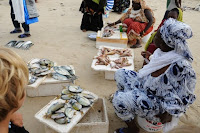

.jpg)




Photos (top to bottom): Illustration showing the extent of the Tertiary and Quaternary volcanics on the Cap Vert Peninsula; the relative position of present-day continents in Pangea; the collision of Laurentia and Baltica led to the formation of the Appalachians, the Caledonides, and the Mauretanides; map illustrating the geological associations among mountain belts across continents; a cross-section illustrating the separation of the Appalachians and the Mauretanides; map illustrating the possible historical links between the North America and West Africa; the stratigraphy of the Senegal Basin (note the references to pre-, syn-, and post-rift sections).
The kids and I are currently exploring the geology of the Cap Vert Peninsula. Generally speaking, two major volcanic periods occurred here: the first centered to the south during the Tertiary, in the area of Cap Manuel; and, more recently, in the Mamelles area during the Quaternary. Thus our field trips to Cap Manuel last week, and to the Mamelles this coming week.
A basic question has been this: In the context of Pangea, 250 million years ago, where was Senegal (in respect to North America). Was it adjacent to the southeast United States? What's the evidence?
With the assistance of USGS geologist Paul Schuster, and Professor Ngom, we've discovered that, during the Triassic, Morocco was juxtaposed beside Nova Scotia, and the mountains of the Mauritania were continuous with the Appalachians.
Here are the details: During the Devonian Period (416 - 360 mya), long before the formation of Pangea, there existed two large continents: Euramerica, which straddled the equator, and Gondwana, which occupied much of the southern hemisphere.
Euramerica was formed from the collision of two other landmasses, Laurentia and Baltica, the result was the formation of a mountain chain stretching south to north across the young continent.
By the end of the Carboniferous Period (300 mya), the continents of Euramerica and Gondwana had fused together to form Pangea. The splitting apart of Pangea, and the formation of the Atlantic Ocean, divided Euramerica's mountain chain. The two halves drifted apart, bordering either side of the expanding Atlantic, forming the Appalachians, the Caledonide Mountains of the British Isles, Scotland, Norway, Sweden, and eastern Greenland, and the Mauritanides of western Africa.
While I'd love to find direct evidence of the connection between the Mauritanides and the Appalachians, there's not much to be found here. The coasts of Senegal, Guinea Bassu, and Mauretania lie on a coastal basin, west of the Mauritanides Belt. We are riding on a thick layer of sediment. Reaching the deeper, pre-rift and syn-rift layers (referring to the period prior to and during the breakup of Pangea) requires drilling equipment, which has been done.





































